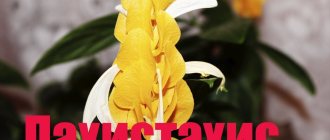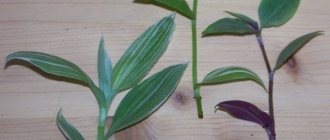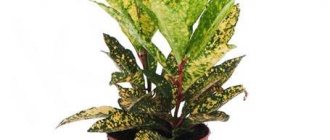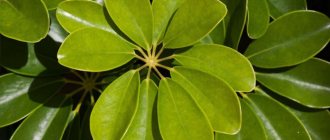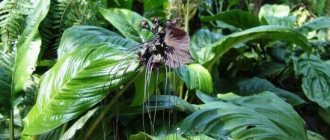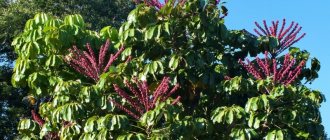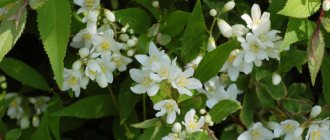Directory of indoor plants
Perfectionists will understand me - the cheflera grows quickly, but something always happens, and it begins to stop at some stage or become distorted.
I personally don’t like it when my shefflera turns from a straight plant into some kind of twisted stalk, so I fight with it until my persistent methods defeat the stubbornness of the shefflera. Trimming the top of the shefflera is already a common thing in monthly care. I try not to repeat pruning often, because the plant weakens a little after it. I often use the tip in the method of cutting Schefflera with apical shoots, which I safely place in water, and then wait for the first roots to be transplanted into a special simple and loose substrate for further development.
I cut the tops large enough, so that after trimming the cheflera it becomes much shorter than it was. I don’t know if it’s right to cut off 20 centimeters from the top at once, but the plant then grows like a wild one. I use this technique when the cheflera begins to slow down in his development. Since the cutting that was cut was adjacent to the main stem of the sheflera plant, a few weeks later a new thin arrow appears in the same cut place, which is already beginning to produce leaves.
You can almost simultaneously trace the tendency of germination of Schefflera cuttings that were cut and new branches from the main stem of the plant from the place from which the cut was made. One day my cheflera actually started to rot. I had to cut everything down to an even line and throw away the entire top. I don’t think it was so fatal for the sheflera, because mine is still alive. Trimming the top is still a very pleasant and effective way, at least for the owner, when the plant no longer fits on the windowsill, and why not the entire distance from the floor to the ceiling. I don’t advise the chefler to let it grow to such a size, because then it will be a pity to cut it off, you will crumple at first, put it off until tomorrow and admire it. But it is necessary to trim the top, because then the cheflera will slow down its growth and cease to please, and such a large plant needs to be placed somewhere.
To walk you through the process itself, I’ll explain how to carry it out. Take a pruner, wipe it, and cut off the apical shoot of the sheflera right under the main trunk. Cover the cutting area with something if the plant is dense and large, and if it is young, it will heal successfully on its own. The cuttings can be processed, the leaves can be cut off from the bottom, the stem can be cleaned a little and rooted, or you can simply throw them away. After this, feed the adult sheflera plant, give it water and make sure that parasites do not attach themselves. The same is true for cuttings - they are weakened and will not be very comfortable at first, so they are very vulnerable to disease. They need to be kept in partial shade in water for the first time, and when they take root, they should be kept in the soil substrate and on the windowsill, next to the mother plant. Make sure that if the adult plant from which you cut it was sick, then in no case should you place young cuttings nearby, and after placing them in the soil, immediately prevent that disease, virus or parasite. which was picked up by an adult cheflera - this way you will save the cutting from a possible disease.
Please rate the material you read :)
The charming umbrella tree in the wild is represented by more than 200 species, of which several especially decorative ones are grown at home. The pruning of sheffler, which is demanding in terms of growing conditions, is no less important than watering and fertilizing, and is loved by flower growers for its unusual beauty.
Planting and care
Many people grow Schefflera indoors; it is unpretentious. It grows quickly and as a result grows into a beautiful plant with leaves blooming in different directions. For planting, the soil must be selected. It should be low acidity and light. The soil is purchased in specialized stores or prepared independently. There are two popular and available options:
Soil for palm trees also contains beneficial components. On sale you can find special soil for all varieties. At home, the Schefflera flower does not require special care; it is enough to care for it according to the following rules:
- The presence of high air humidity in the room is most suitable for bushes, but at the same time, they are not afraid of indoor conditions. However, the leaves are regularly sprayed with settled water at room temperature.
- Schefflera loves light, but direct exposure to sunlight is unacceptable for him. In summer, take it out into the fresh air, placing it in partial shade.
- The flower is watered once every two days. When watering, it is especially recommended to use soft, settled water at room temperature, while monitoring the soil. It should have the consistency of a wet, sticky lump. In winter, watering is done less frequently.
- The tree is placed in a place that is spacious for its growth, taking into account the amount of light. Drafts and close proximity of heating devices are contraindicated for plants.
- Fertilize once a year, in March or October. 200 g of ash per bucket of water, mix thoroughly and water with this solution once every 2 weeks.
- The soil of young Schefflera is changed annually, in spring or autumn. For an older plant, this procedure is carried out when the ground at the planting site is entwined with roots. The pot for replanting is taken with a diameter 2-3 cm larger than the previous one, the type of soil is the same as that used for planting.
- The optimal temperature for the flower is +17-+20 °C. When a given elevation rises or falls, the foliage falls off.
- Since the plant reacts negatively to pruning, this procedure is best neglected. To add splendor, 3-4 seedlings are grown in 1 pot. As a last resort, pruning is carried out at the base, cutting off the lower branches.
During the dormant period, Schefflera stops its growth. At this stage, which begins at the end of November and ends in March, the air temperature is reduced to +16-+18 °C and watering is reduced to a minimum.
Scheffler's home flower, description
Schefflera (Araliaceae family) pleases with a variety of natural forms - tree, bush, liana. Particularly interesting are the leaves, similar to wide-open palms, colored in emerald green; some varieties have a variegated color. They are especially popular. Types suitable for home floriculture:
- radiate leaf (Shefflera actinophylla);
- eight-leaved (octopus, Sh. Octophyla);
- tree (Sh. Arboricola);
- palmate (Sh. Digitata);
- most graceful (Sh. Elegantissima);
- Veitch (Shefflera veitchii).
What varieties are found?
At home, they grow eight-leaf bush sheflera, which has an elegant appearance. Its drooping petioles are cream-colored. They bear shiny, dark green, lancet-shaped leaves. Their length reaches 40 cm. The plant is light-loving, and does not have enough color days to bloom on the windowsill. Under artificial light, a flower appears that resembles a light green sea mollusk in shape.
Schefflera eight-leaved
For bonsai lovers, Schefflera arborescens is suitable. You can grow the Amate variety with green leaves or the Gold Capella variety. This variety of sheflera looks like a miniature palm tree with variegated leaves, which are about 20 cm long.
Schefflera arborescens
Schefflera radiata (or star-leaved) has a brown trunk and elongated shiny green leaves. The Nova variety is distinguished by its leaf, similar in shape to oak leaves.
Schefflera radiata
Forming a tropicana correctly
Lovers of indoor gardens are often lost when it comes to pruning exotic plants. The procedure can often cause harm. Let's deal with everything in order.
Is it possible to prune Schefflera?
First of all, you need to remember that the event significantly reduces the decorative effect. Therefore, flower growers often do without it. The degree of importance of shortening the sheffler is determined by the species or varietal:
- Radiant-leaved species, which have a single stem, are allowed to grow without intervention.
- Tree-like branches are shortened as they grow, which saves space.
Why does Schefflera need pruning?
Exotic grows quickly, but sometimes growth slows down catastrophically for no reason. It happens that a plant, or rather its stems, begin to bend on their own, taking on a shape that does not closely correspond to the owner’s intentions.
To stimulate the normal growth of the tropical guest, part of the shoot is removed. They do the same thing to form a lush crown - it rarely shows the ability to branch without external influence. And maintaining a neat shape without “surgical intervention” is simply impossible.
When is the best time to prune an umbrella tree?
The optimal time for formation is the beginning of spring, still during dormancy, but awakening is about to begin.
Trimming tools
By the end of the season, young shoots become woody and the bark becomes dense. A sharpened garden pruner is considered the best tool; a kitchen pruner is suitable if the shoots are thin. Important condition! The tool must be disinfected before starting work.
Forming an umbrella tree at home
They form a flower according to their wishes: a slender tree with a fluffy crown, a branched tree, a bush, weave trunks, etc.
How to trim the top correctly
Pinching the tip is usually necessary to force the plant to produce side branches. A peculiarity of all shefflers is that the axillary buds sleep until they receive a stimulus to awaken - the removal of the upper part of the trunk.
If you cut 1-2 leaves from the top, the upper eyes will wake up and growth will resume only upwards. Therefore, the crown is removed, counting out at least 5-6 petioles, and several equivalent buds are obtained that are capable of producing side shoots.
There is an interesting way to force a wayward tropical tree to branch: the tree is carefully bent down and fixed. After some time, the eye located above the rest will wake up and begin to grow. The cut part is usually rooted, i.e. used for reproduction.
How to form a crown
Before taking the pruning shears, the gardener must decide what he wants his green friend to look like: a spreading bush, a slender tree, an exquisite bonsai.
Forming a tree
First, wait until the flower reaches the desired height plus 5-6 leaves. Then the top is cut off. Since cases when all the buds wake up are extremely rare, experienced gardeners advise using the technique that gardeners resort to when forming the crown of fruit trees: the bark is cut above the eye at a height of about 1 cm. At the same time, the flower behaves like an apple tree, immediately responding with young shoots.
Ways to braid a shefflera
You can get a beautiful crown by planting several sprouts together, preferably vines - their trunks are more flexible:
- Double helix. A support is installed between two young shoots and the stems are wrapped around it. Carefully secure it at the top with a clamp, leaving a gap so as not to damage the stems.
- Pigtail. Braid from 3-4 young plants, also using support.
- Lattice weave. A flower lattice-support is installed next to 2-4 sprouts, they are entwined with flexible shoots, guiding them randomly.
When is the best time to prune?
Like any other manipulations with plants, pruning should be done in the spring. Most often this is March–April, the time when the plant wakes up from hibernation and all life processes resume.
It is not worth trimming bushes at other times of the year. In the fall, they prepare for hibernation and may not recover (or not fully recover) after the procedure. In winter, when the plants enter a dormant period, there is no need to touch them at all. They rest and gain strength for the new season.
The optimal time for any operations is spring.
Rested, with a supply of fresh strength and juices, the plants feel great and endure all procedures with vigor.
Basics of plant care.
Sheflera came to our latitudes from the hot and humid subtropics. Under natural conditions, it blooms beautifully and even bears fruit. Do not rush to rejoice, the decorative species has practically lost the ability to bloom at home; it is an exception to the rule. But you still have a chance to enjoy all the beauty of sheflera, all you need to do is:
- Maintain optimal temperature. It fluctuates in the range of 18-23°C.
- Provide adequate lighting. To do this, it is enough to place a pot or tub with a tree near a window on the east or west side.
- Monitor the humidity level. The plant can be saved from pests by regular water treatments and spraying.
- Feeding with minerals will be very helpful. Especially in the spring and summer.
If these rules are strictly followed, you can move on to the next stage - crown formation.
Necessary equipment
For high-quality pruning of shefflera, you need to stock up on reliable, sharp pruning shears, garden pitch and activated carbon or other antiseptic. You cannot use scissors when pruning - they can cause additional damage. It is much safer and more convenient to use a professional tool specifically designed for these purposes.
They can’t do without an antiseptic - they will need to treat the cut sites. This will help reduce healing time and prevent infection or pests from getting into the wound. For thick branches, garden pitch is used for the same purpose - a viscous substance similar to plasticine or putty, which is used to cover wounds and damage on the trunks and branches of plants.
How to form a flower correctly?
Schefflera is an undemanding plant that is quite easy to give the desired shape. For example, to form a tall tree with a rounded crown, you need to provoke the growth of side shoots, which are then pruned in the shape of a ball. To do this, you need to trim the top of the tree a little, cutting off 6 or 7 internodes.
You can plant several plants in one pot at once - their intertwined trunks combined with a lush green crown will create a very beautiful composition.
To get a fluffy branchy bush, it is necessary to provoke the growth of side shoots at a low height. To do this, you can cut the trunk above the unawakened bud. This technique leads to the fact that the plant begins to produce branches throughout the trunk.
Common mistakes
- Lack of lighting for Scheffler is the biggest and most common mistake, which always leads to problems in the growth and soreness of the bush. So, the leaves may be faded and lose color (if they should initially be variegated). The trunk is formed crooked and thin.
- Schefflera intensively sheds leaves, usually for two reasons: either it is too cold in the room, or it is too hot.
- The leaves dry out at the tips or brown spots appear on them. Often the reason is excessive waterlogging of the plant.
- Light spots or even withered areas begin to appear on the leaves - this is a sign of excessive light or even direct sun.
Follow-up care at home
Despite the fact that Schefflera came to us from tropical latitudes, it is quite undemanding in care. Even a beginner, inexperienced gardener can grow it. But there are still certain rules, and they must be followed in order to get a strong, healthy plant. To provide the bush with the necessary conditions, you first need to understand what type and variety of shefflera you will be dealing with. Each of them has its own requirements; there are more or less whimsical ones, those that tolerate direct sunlight, and those for which it is contraindicated.
In order not to destroy the plant, you need to clearly understand which particular variety of this tropical inhabitant came into the house.
However, there are requirements that are the same for any variety.
To the soil
It can be either purchased or prepared independently. In the first case, you will need to add sand. If the soil is made at home, you will need to stock up on turf, leaf soil, plant humus and river sand. Each subsequent component is taken in a smaller volume than the previous one (for example, 4: 3: 2: 1).
Sand - whether added to purchased soil or when making a homemade mixture - must be calcined in the oven or microwave , and then allowed to sit for a month in a cool and dark place. This is necessary so that possible pests living in the river sand die under the influence of high temperature, and the beneficial microorganisms necessary for normal growth have time to recover in it.
In addition, a layer of expanded clay must be laid along the bottom of the pot in order to ensure good soil drainage. It is also very important to ensure that the soil surface is compacted.
To the temperature regime
Although Schefflera arrived in our latitudes from the tropics, it does not like excessively high temperatures. The optimal mode will be: in summer +22 degrees during the day, +16 at night, and in winter – from +14 to +16 degrees Celsius.
Towards humidity
Sheffler likes humidity, but, of course, also within reasonable limits. Creating comfortable conditions for her is not so difficult. It is enough not to place the plant near air conditioners and heating devices, regularly (at least twice a day) spray the bush and periodically wipe the leaves.
To illumination
This is where the type and variety of the plant matters. For example, there are varieties with patterns on the leaves. If such a plant is exposed to direct sunlight, the design will fade and the plant will lose its attractiveness. Some varieties, in general, can get sunburn - brownish spots on the leaves.
Therefore, Schefflera is not exposed to direct sunlight. It is not placed on window sills, especially if the window faces south. But she doesn’t like shade either, and it won’t be possible to place the plant in the back of the room. It is best to place it near a window (on a table, for example), so that it receives enough light, but is not in direct sunlight, from which it needs to be covered.
To watering
Shefflera is watered every 2-4 days in the warm season, and once every 10-12 days in the cold season.
This plant loves moisture, but you should not overdo it with watering. To understand whether it is time to water the Schefflera, you need to touch the top layer of soil in the pot - it should be only slightly damp.
If the plant is already large, it is best to place it in a special tray filled with pebbles and pour water into it. The plant itself will take the required volume.
For feeding
There are few rules here. It is enough to remember that liquid fertilizers are applied every 10 days, stopping only in winter, from December to February. And in the spring and until autumn, the plant is sprayed every month with special bioregulators (for example, “Zircon”, “Epin” and others).
That's all the simple rules for growing and caring for shefflera. This tropical beauty is surprisingly unpretentious, and even a novice plant grower can satisfy its requirements. And she will thank you with bright greenery, thick crown and good health.
Alternative methods of reproduction
It is almost impossible to obtain schefflera seeds at home, so you will have to purchase them in the store. They are sown early - in January-February. To increase germination, the seeds are pre-treated with a growth stimulant (Epin, Zircon).
The planting container is filled with peat mixed with sand or a substrate made from the following components:
- turf land;
- leaf soil;
- sand.
The recommended planting depth is 3 seed diameters. Having finished sowing, the container is placed under glass or covered with film. Schefflera seeds germinate at a temperature of 20-24°C. Caring for crops comes down to daily ventilation and moistening the soil as needed.
When the seedlings produce 2-3 true leaves, they are picked into separate pots. They should not be large - from 7 to 9 cm in diameter. Spiked shefflers need coolness. The temperature in the room with them is maintained at 14-16°C. Closer to autumn, they are replanted again, using pots whose diameter is 10-12 cm. They need a substrate almost the same as crops. Only the proportions change: the components are mixed in a ratio of 2:1:1.
To propagate an adult shefflera by air layering, a vertical cut is made on its trunk. Sphagnum moss soaked in a nutrient solution is applied to it. It is prepared from complex fertilizer or immunomodulator drugs. Add 1 g of substance to 1 liter of water. Having pressed the moss to the trunk of the shefflera, it is tightly wrapped with film on top. Constant humidity must be maintained under it, this must be carefully monitored.
Soon roots will appear at the cut site. When they grow up (this will take about 2 months), the flower is cut off and planted in a pot. There is no need to throw away your old shefflera. It is cut off, leaving a low stump. If you water the plant, it will eventually produce young shoots.


